ISSN: 1204-5357
ISSN: 1204-5357
| ZAKARIA SALEH, PhD Associate Professor, IT program, American Intercontinental University, USA Postal Address: AIU, Schaumburg, IL 60173, USA Email: Zak.Saleh@aiuonline.edu |
| Dr. Zakaria Saleh is an Associate Professor in IT at the American Intercontinental University, USA. His work experience ranged for simply providing technical support and non-conformance resolutions for a “Compaq Computers” PC configuration center, to working on the design and development of electronic control systems in the Automotive Industry, where he has contributed to the introduction of the M2M (Machine to Machine) Communication Systems. Prior to joining academia, he was working as a Project Engineer, at Case Corporation, an International Designer and Manufacturer of Agricultural and Construction Equipment, located in the USA. He was the lead engineer to work on the design and development of web based Fleet Management System. |
Visit for more related articles at Journal of Internet Banking and Commerce
The research into consumer choices and acceptance of new products and services is normally discussed within the framework of diffusion of innovations and has traditionally relied on identifying consumer characteristics while focusing on the characteristics of innovations. The purpose of this study is to examine the impact of Identity theft on the perceived level of security mad trusting E-Commerce.
Keywords |
| E-Commerce; Identity Theft; Internet Security; Risk |
INTRODUCTION |
| The enormous growth of Internet technology has made various resources on the Web instantly accessible to users. E-commerce has become a very important technological advancement for businesses in changing business practices (Brodie et al, 2007; Gonza´lez et al, 2008). The business organizations have also developed strategies to use the technology and expand their customer base and implement Electronic commerce (e-commerce) to deliver their products or services to the market through their ability to organize and maintain a business network. With any information technology, such online selling of products and services, ensuring transaction security is vital. However, measuring the security perceived by consumers usually involves some type of financial, performance, or social risks, where financial risk is not just the risk of losing money. In fact, Identity theft due to poor security measures could affect consumers’ credit ratings or bank balances. |
IDENTITY THEFT , INTERNET SECURITY, AND E-COMMERCE |
| While recent advancements in computer processing makes it easier for businesses and consumers to reach each other, they can also make suitable grounds for an impostor to obtain personal identifying information and then commit a crime known as Identity theft. |
| Identity theft is a one of the fastest growing crimes in which a criminal obtains key pieces of personal information in order to use it for own personal gain. Microsoft (2012) extends the definition of identity theft to be any kind of fraud that results in the loss of personal data, such as passwords, user names, banking information, or credit card numbers. Identity theft techniques can range from unsophisticated, such as mail theft to sophisticated tricks in which a pretender adopts somebody else’s identity to gain access to their assets. |
| Identity theft is not new, and there have always been frauds who would use someone else’s personal information such as name, social insurance number (SIN), credit card number or other identifying information to carry out fraudulent activities. However, technology, mainly the Internet, facilitates more harming schemes that in many cases results in financial loses and in some cases the victims of identity may experience difficulty obtaining credit or restoring their name. |
| Moreover, the problems caused by many computer virus, which swept computer systems worldwide in many cases, the distributed denial of service attacks on many ecommerce sites in the United States and Europe, as well as the hacking into the government’s Web sites demonstrates the security of the Internet. In some cases, the attacks resulted in disclosure of sensitive customer data, and in some instances they did substantial damage to user/company relations, and they have caused inconvenience and frustration for millions of Internet users and increased concerns about the trustworthiness of the Internet. |
| E-commerce is on track to account for 53 percent of all purchases by 2014, according to recent Forrester Research predictions. This represents positive growth, but when you put it into perspective based on the Internet's overall growth potential, it's only a 10 percent annual increase (Mulpuru and Hult, 2010). |
| An Internet Usage Statistics, that was published by Miniwatts Marketing Group (2011) shows that the worldwide Internet users in December of 2000 were “360,985,492”, and in December 2011 the number of users became “2,267,233,742” , with a growth of 528.1% (Miniwatts Marketing Group, 2011), (see table 1 for number of Internet users). |
| According to Hernández et al. (Hernández et al, 2010), more and more consumers buy groceries and other foodstuffs via the Internet, and thus sales volume has been growing for the past 5 years at greater than 25% per year compared with stagnant increase in the overall market for foodstuffs. Appearance of the web site influence trust in the site through perceived ease of use (Vance et al, 2008), the consumer decision process has dramatically changed, even over the relatively short period of time the Internet has been with us (Edelman, 2010). Buyers in electronic markets are more susceptible to the lemons problem, as there is more incentive for sellers to market poor quality goods (Kshetri, 2010). |
| According to James (James, 2010), consumers' security fears can be categorized in three ways: the fear of identity theft and fraud; a negative perception of the merchant's security practices; and hesitation during the checkout process. Although more Americans than ever are going online, more Americans than ever distrust the Internet according to Tenth Study by the Digital Future Project (USC, 2011). The reports finds high levels of concern about corporate intrusion in personal lives, where Sixty-eight percent of Internet users said they buy online, however, respondents continue to report high levels of concern about credit card security when or if buying online, a finding that has continued in all of the Digital Future studies. In addition, while large percentages of Internet users buy online, even larger percentages continue to use the Web as a reference service before purchasing from local business. |
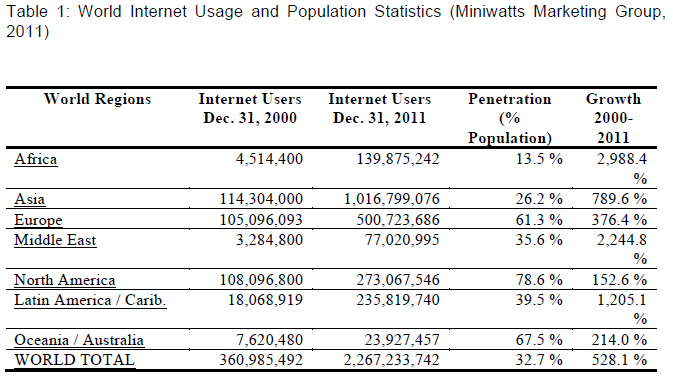 |
| According to TowerGroup (2009), there are almost 600 million E-Commerce users worldwide with a project growth rate that far outpaces the other banking services of ATM, branch and contact centers. The number of E-Commerce users globally is increasing at a compound annual rate of 20% through 2012, the firm said. |
| The open, interconnected nature of the Internet, which makes it such a useful and powerful medium, also makes it vulnerable to a variety of attacks. In recent years, there have been a variety of types of cyber-attacks. In general, the most important that relate to E-Commerce are: Denial of service, Cookie switching, IP spoofing, and Web spoofing, and identity theft. The performance and reliability fall short of expectations for commercial-grade sites and applications, however, as the end-user experience is at the mercy of the unreliable Internet and its middle mile bottlenecks (Leighton, 2009). In order to thrive in tomorrow's banking environment, TowerGroup recommends that banks focus on bolstering their e-Commerce channel to not only fend off disintermediation by nonbank players, but also to position their websites as the financial center whenever the consumer goes online. Banks have historically been the financial focal point for consumers, and in order to maintain their role as dominant financial advisors, they must dedicate their resources to improving their e-Commerce channel so that customers turn to their website for all of their banking needs (TowerGroup Research, 2009). |
HYPOTHESIS |
| Intentions to use the Internet for purchasing products or obtaining services are positive indications and necessitate that a customer visits a business website and then complete a transaction. While the first phase was all about individual choices and better value for consumers, the second phase of Internet commerce is being redefined by the social media revolution of the last decade (Barwise and Meehan, 2010). |
| H01: Internet users do not have a negative attitude towards E-Commerce. |
| The Internet has opened up a world of opportunities for organizations to enhance operating efficiency, reduce costs, improve communication, and improve information delivery. However, the Internet also provides an opportunity for an intruder to compromise personal data and uses them for own personal gain. |
| H02: The Perceived level of the Internet security is positively associated with the level of customers concern about Identity theft. |
| Securing the Internet, like any other fields of computers, is based on the principle of confidentiality and integrity. Internet security incidents can be costly to the businesses that sell or provide services online. Other consequential damages are loss of reputation and loss of customer trust. |
| H03: Perceived level of internet security is positively associated with trusting ECommerce. |
| The introduction of electronic payment complicates the process of secure payments. To complicate matters, the Internet was never designed for protection. Conversations about the opportunities and vulnerability of E-Commerce are to be found in almost every trade magazine and industry forum. |
| H04: Computer technical competence is positively associated with the perceived level of E-Commerce security. |
| There is still debate over the definition of identity theft, and the lack of consensus on a definition makes measuring identity theft a challenge. In addition, Lack a clear picture of the extent of identity theft or have good information about the sources of personal information being used by identity thieves. People will not trust what they do not understand. |
| H05: Clear understanding of the extent of identity theft, is positively associated with trusting E-Commerce |
SURVEY DESIGN |
| A survey was designed to find out the perceptions of Internet users about Internet security, understanding of the extent of identity theft, and find out whether or not these perceptions and understanding have any effect on trusting E-Commerce |
| The study was conducted in August of 2012 by having shopping mall “visitors” take a survey in three different locations in the State of Illinois (in three different counties). Only participants who use the Internet were allowed to take the survey (to eliminate the bias of none-Internet users). A total of 217 responses were received and used for this study. |
| Of 217 Internet users, 128 of them were male and 89 were female. The majority of the participants were between the ages of 18 and 43 (178 participants). 144 participants indicated that their level of education was two to four years college, and 73 participants had high school or less. Most of the participants’ computer skills fall between average and high (161 participants). The Majority of the participants indicated being confident accessing the Internet (191 participants), and the majority of the participants use the Internet for more than five hours a week (165 participants). |
HYPOTHESIS TESTING |
| The First Hypothesis (H1): Our first hypothesis is that Internet users do not have a negative attitude towards E-Commerce. Testing this hypothesis, the mean attitude score is 5.2 in the scale of 1 to 7 where “1” stands for “extremely disagree” and “7” stands for “extremely agree”. The standard deviation of the attitude score is 0.85. The median of the attitude score is 5.95. The distribution is fairly symmetric about the mean (see figure 1). |
| The independent variables were scaled between 1, indicating respondents strongly disagreed, and 7, indicating respondents strongly agreed. A score of 3.5 on this scale indicated a neutral value. Since 3.5 correspond to the neutral point, we formulate the following statistical hypothesis in order to test our first hypothesis: |
| Null hypothesis: The average attitude score is equal to 3.5. |
| Alternative hypothesis: The average attitude score is greater than 3.5. |
| Using a one-sample t-test, we find an extremely small P-value, less than 0.1% (t-value is 6.66), which means that we can reject the null hypothesis at 0.1%, a very significant level. The testing result indicates that Internet users do not have a negative attitude towards E-Commerce, and it is so at a very high degree of confidence (at least 99.9%). |
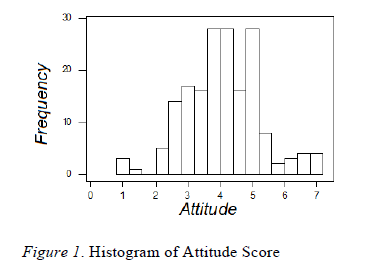 |
| The Second Hypothesis (H02): We stated that the Perceived level of the Internet security is positively associated with the level of customers concern about Identity theft. Testing this hypothesis, the mean score for Internet security is 4.57 and the mean score for customers’ concern about Identity theft is 4.27 in the scale of 1 to 7. The standard deviation of the Internet security score is 1.55 and the standard deviation of the customers concern about Identity theft score is 1.55. We tested to see if the slope significantly different from zero, and found that the P value is 0.349, which is considered not significant. We counted the number of runs, to see whether or not it indicates a linear model. The linearity evaluation is conducted by counting runs. |
 |
| Small runs would indicate that the data deviate substantially from linearity. However, in the sample of 217 points, it is found that there are 83 points above the line, 94 below, and 92 runs. The P value is 0.693, which is considered not significant (see table 2 and figure 2). Based on the above testing result, we can reject the hypothesis. |
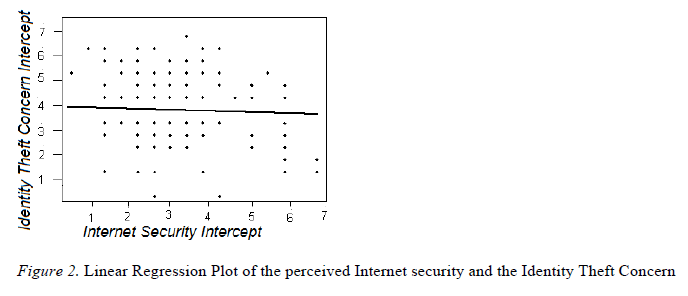 |
| The Third Hypothesis (H03): We stated that the perceived level of internet security is positively associated with trusting E-Commerce. Testing that hypothesis, and at 95% confidence interval, we find that the correlation coefficient (R) = 0.447, and the R squared = 0.190. We also tested to see if the slope is significantly different from zero, and found that the P value is <0.0001, which is considered not extremely significant (See figure 3). Based on the above testing result, we can accept the hypothesis. |
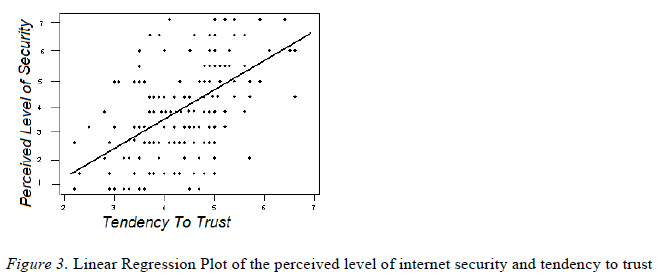 |
| The Fourth Hypothesis (H4): Our Fourth hypothesis states that Computer technical competence is positively associated with the perceived level of E-Commerce security. The Pearson correlation coefficient between the technical competences of Internet users the user's perceived level of E-Commerce security is 0.66, which indicates a fairly strong positive correlation. The P-value in testing the zero correlation is less than 0.1%, which means the correlation is very significant. Figure 4 presents the linear regression plot of the Pearson correlation coefficient. Based on the above testing result, we can accept the hypothesis. |
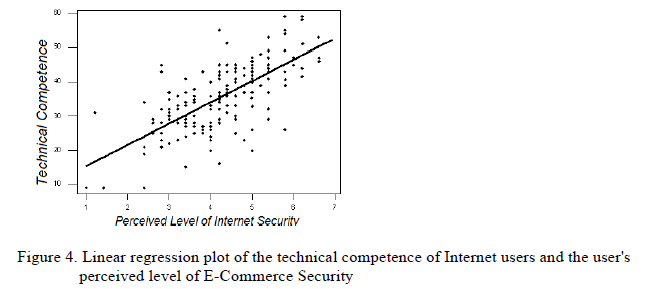 |
| The Fourth Hypothesis (H5): We stated that the clear understanding of the extent of identity theft is positively associated with trusting E-Commerce. To seek the association between the users' tendency to trust E-Commerce and having clear understanding of the extent of identity theft, the correlation analysis was conducted. The Pearson correlation coefficient is found to be 0.209 and the corresponding P-value is 0.004 or 0.4%. This means the positive correlation between the two measurements is statistically significant though it is not strong. Figure 5 illustrates the users' tendency to trust E-Commerce and having clear understanding of the extent of identity theft. |
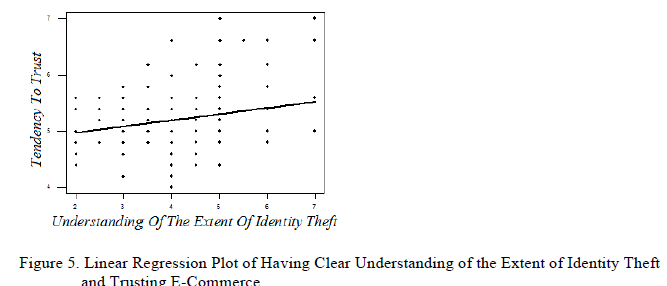 |
| ANALYSIS AND CONCLUSION |
| Consumers have changed their spending habits to adapt to this new economy. Shoppers are more selective and cautious about how they spend their money, and security apprehension still remains a hindrance to e-commerce (Mulpuru and Hult, 2010), and while Identity theft is not new, and there have always been frauds who would use someone else’s personal identifying information to carry out fraudulent activities. |
| This study finds that Identity theft is one of the fastest growing types of fraud. |
 |
| Analyzing the Incidents Crime Reports of The Internet Crime Complaint Center (IC3), for the calendar years 2009–2011 (table 3), we find that Identity Theft is on the rise, and has moved from being the fourth of the Top 5 Most Common IC3 Complaint Categories to become the second most reported crimes in 2011 (IC3, 2009; IC3, 2010; IC3, 2011). The analysis also indicates an increase of 35% over the year 2010 and 150% increase over the year 2009. In addition, analyzing the IRS, IPSU Identity Theft Report for the calendar years 2009–2011, reported 1,125,634 incidents (IRS, 2011). Comparing this number with 2009 and 2010 reported incidents, we find an increase of 155% over the year 2010 and 146% increase over the year 2009 (see table 4). |
| An interesting observation is that of all the complaints in the IC3 reports, only 36.9 percent reported financial loss, this data could be interpreted in different way, assuming the efficiency of prevention action or only considering that some complaints are only related to tentative of crime. What is interesting is that analyzing all complaints reported is helpful in identifying trends and building statistical reports on the crimes. Another interesting point to make is when looking at table 4, the number of incidents of identity theft is higher than the number of taxpayers. The fact is, some people had more than one incident of identity theft. |
 |
| Identity theft is obviously a complex problem. Organizations clearly need to do a better job at safeguarding the personal information entrusted to their care. The analysis of the data obtained from IC3 and IRS points to an explosion of identity theft. |
| In addition, the data collect by this study, indicates that consumers currently do not have a great deal of trust that the organizations holding their personal information are protecting them against identity theft. The participants believe that it is the merchant's responsibility to prevent identity theft during and after any online transaction. That suggests if any security issues occur while on the site or in the future, not only the blame will fall on the merchant, but also, it will impact future transactions. |
| The study finds that the participants agree that weak authentication and authorization is a significant E-commerce security risk for customers. This was recognized from the participants’ answers on the questions of whether or not the website allows users to make multiple log-in attempts without locking the account (58% of the participants made multiple log-in attempts), and whether or not this would be a significant security risks (100% fully agreed). |
| The study does not find a significant correlation between Perceived level of the Internet security and the level of customers fear about becoming victims of Identity theft. Before the study was conducted, the expected outcome was that participants who believed that the internet is secures would have less or no fear of becoming victims of Identity theft than the participants who believe that the Internet is not secured enough. But we were getting mixed answers, and some were extreme (e.g. strongly agree that the Internet is secured and strongly agree that they could become victims of Identity theft). |
| However, when we found positive correlation between users' tendency to trust ECommerce and having clear understanding of the extent of identity theft, we looked at the surveys of the participants who supported this expectations, and no mixed answers were found among those participants. Which suggest that there are people who have no trust in the system no matter how secured it may be, and there should be some kind of assurance done by merchants to gain the trust of those people. Trust is central to customer’s merchant’s relationships and it is crucial when it involves risk and uncertainty. Since the possibility exists for a third party to obtaining personal identifying information, this increases uncertainties, and therefore, the need for trust grows. |
References |
|
Copyright © 2025 Research and Reviews, All Rights Reserved